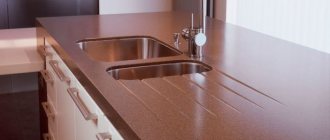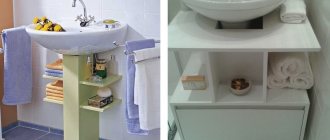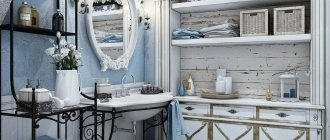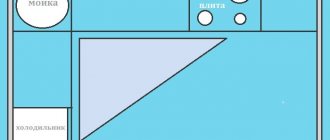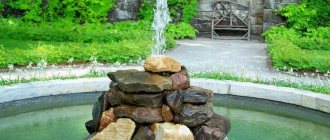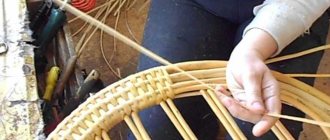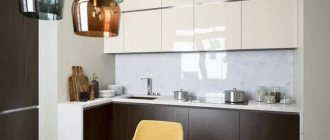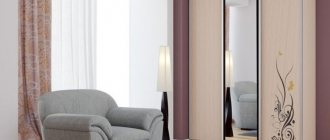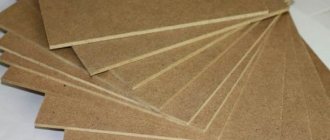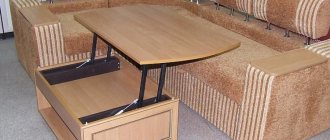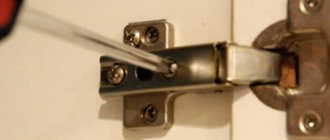0
44205
For a long time, chipboard (chipboard) has been used as the basis for furniture. For those who have minimal skills in working with wood and carpentry tools, homemade furniture will provide an opportunity to significantly save the family budget. Do-it-yourself furniture made from chipboard will be exclusive and will take its rightful place in your apartment. Everything you need for work can be found in specialized stores.
What it is?
Laminated chipboard is a regular chipboard , which we talked about here, lined with a decorative coating .
The coating can be either single-color and smooth, or multi-colored or imitating wood texture.
Main characteristics such as:
- bending strength;
- ability to hold a screw;
- density;
- moisture resistance classes;
- formaldehyde emission class;
- flammability
fully correspond to the same characteristics of the source material.
The thickness of the laminated material depends on its purpose. 16 mm thick laminated chipboard is most often used 25–38 mm thick slabs .
Laminated chipboard for cladding walls, floors and ceilings is made from chipboard with a thickness of 8–12 mm .
A laminating layer with a three-dimensional pattern increases the thickness of the chipboard, because such a pattern is created by pressing the base layer , pressing the contours of the pattern onto it.
The outer film only follows the contours of this pattern.
Making chipboard at home
The production of wood-based panels can be carried out on a small production or farm scale. The main limitation is the size of the resulting slabs - no more than 50 × 50 cm.
Manufacturing technology is a miniaturized industrial process in which automatic steps are replaced by manual labor:
- mixing sawdust in a small container (10-15 l);
- adding a binder and ensuring complete impregnation of the sawdust mass;
- shaping with light pressure;
- hot pressing of the workpiece, which requires special equipment;
- cooling the resulting chipboard fragment in air and trimming the edges.
The laminate is glued in the same baking press that is used to produce rough, uncut material. There are ready-made coatings for wood boards that can be “fried” to the surface with an iron. They improve the appearance of chipboard, but are not fully a laminating layer.
The main layers in the manufacture of slabs
How are chipboards made?
To make laminated chipboards, ordinary sanded chipboards are used, so they are produced at a chipboard production plant, connecting a lamination section .
Moreover, 3 technologies are used to cover the source material with a laminating film:
- lamination;
- laminating;
- smooth lamination.
Lamination
When laminating, 1-2 layers of specially prepared paper are glued onto the base , and the first layer - the base - is made as thick as possible so that the design can be pressed into it.
The thickness of the base, depending on the depth of the pattern, can reach 0.5–1 mm, the thickness of the second layer is tenths or even hundredths of a mm.
On top of these layers, another one is laid, made of transparent paper and a mixture of various resins, which, when heated, turn into a durable film that reliably protects the decorative surface.
The base layer is laid on the prepared chipboard surface and pressed down with a hot stamp with a suitable pattern.
The surface temperature of the stamp is 150–220 degrees, due to which the resin that impregnates the base layer is mixed with the resin that glues the chips in the chipboard and the paper becomes an inseparable part of the board .
Then, in the same way, a decorative layer with a suitable pattern and an outer layer are glued, which protects the slab from damage.
At some enterprises, all layers of coating are first connected to each other, then dried and, only after that, attached to the chipboard.
With this technology, the coating is made in the form of a tape. The pattern on it is formed using a cylinder with an installed matrix, similar to the formation of a pattern during laminating.
The difference with laminating is that the tape is attached without glue, heating the resins that impregnate the paper until it melts and mixes with the resin in the chipboard.
Laminating
When laminating, the facing material is first prepared, for which all layers are laid in order and a pattern is printed on them using a cold press .
At the same time, the uncured resin of the various layers is mixed, due to which the coating turns into a wide and long ribbon.
If a cylindrical stamp , then it becomes possible to make ribbons of any length .
Many small enterprises producing laminate with a three-dimensional texture prefer not to spend money on expensive equipment necessary for the production of tape, but to buy ready-made material.
The finished tape is sent to the dryer, then wound into rolls, which are delivered to the laminating area. There, the facing material is cut to size and placed on a slab coated with a special glue, then pressed with a press and heated until the glue is completely polymerized.
Thanks to this technology cladding goes faster , because there is no need to heat each layer of coating separately , so the enterprise can produce more products.
The disadvantage of this technology is that the glued cladding holds much weaker than real lamination.
Smooth lamination
This technology is similar to laminating , but is a full-fledged lamination, because when heated, the resin of the coating and the boards are mixed, forming a single material. In addition, there is no press for creating a pattern .
To create a smooth surface, it is enough to lay 2 layers, the bottom of which will be made of paper , and the top of a special film, which, when heated, forms a durable and transparent coating .
Due to the fact that large chipboard manufacturers are constantly looking for ways to increase production manufacturability and reduce costs, various changes are constantly being made to this process, the essence of which is kept secret by manufacturers. After all, any improvement in the quality of the laminating coating, as well as a reduction in costs, makes their products more competitive.
Dimensions, characteristics, classification
The dimensions of chipboard sheets are standardized by GOST, as are the maximum deviations for each value. But many enterprises form their specifications, increasing the permissible deviations. Therefore, when purchasing a batch, do not be lazy to measure several sheets to choose from. So, the dimensions of the chipboard boards are as follows:
- Thickness: 10, 13, 16, 19, 22, 25 mm. The maximum deviation for ground ones is 0.3 mm, for unpolished ones from 0.4 mm to 0.7 mm depending on the thickness. The length, width and thickness of the sheet are determined by GOST
- Width: 1220, 1500, 1750, 1830 mm. Permissible deviations are 3 mm.
- Height: from 1800 to 3500 mm in increments of 10 mm, dimensions may differ from nominal by 5 mm.
In terms of height, there is usually not such a large assortment. Most often you can find 2440, 2750 and 3060 mm. There are also “halves” in width - 910 mm.
Grade
Depending on the quality of the composite material, chipboard is divided into the following grades:
- 1st grade. Ideally smooth surfaces and edges. No foreign inclusions, chips, delaminations, or other defects. Most often, most of the first grade is sent for further processing - grinding, laminating, etc.
- 2nd grade. There are some minor defects. These may be cracks, irregularities, deviations in thickness within a small range, or delamination of the composite. Not all of these shortcomings together, but only some. The higher the density and more uniform the structure, the stronger and stronger the slab
- Substandard products, or, more simply put, defective products. Significant defects listed above. It can only be used as removable formwork, and even then not for all areas.
Whatever the sellers claim, significant defects are defective and therefore cheap sheets. And they should not be used for construction. Neither for sheathing, nor as sheathing. Unless in a barn on partitions, and even then...
Brand
There is also a classification of chipboard as a brand. There are only two of them:
- P-A. More tensile and bending strength, has less roughness, and is less prone to swelling and warping when the standard humidity is exceeded (the degree of deformation from water is 22%). Two brands and the best is P-A
- P-B. More fragile, not so smooth, has lower water resistance (the degree of warping from high humidity is 33%).
The P-A grade of chipboard is worth buying for those jobs in which appearance is important or strength requirements are high. In other cases, it is better not to spend extra money.
Number of layers
Initially, monolithic particle boards were created. They consisted of one layer. The material was not very durable, flaked at the ends, and had an unpresentable appearance. But it was used because single-layer chipboards have good characteristics at a low price.
A few decades later, after numerous experiments, they began to make three-layer chipboards. Large chips are selected into the middle layer, and the outer two are formed from small chips. In this case, the material is monolithic, there is no separation of layers. This allows you to simultaneously increase strength (not so brittle when bending), improve appearance (small chips make it possible to sand smoothly) and not raise the price too much (due to the use of large chips). So three-layer chipboard can be called the optimal choice.
Three-layer material is more durable. But the loose inner layer imposes restrictions on application
There are also five-layer chipboards. But they are expensive, rarely appear in stores, and are almost impossible to find in markets. This is one of the types that is made to order. Used in carriage building and other “serious” industries.
Water resistance
Initially, chipboards had low water resistance and could not be used in damp rooms or outside buildings. To improve this characteristic, paraffin or paraffin emulsion was added to the mass. The material is usually called moisture-resistant chipboard, and its swelling from moisture is 15%.
Standard Features
Moisture-resistant building chipboard is used for the outer cladding of frame houses and for continuous lathing for some types of roofing materials. Laminated moisture-resistant chipboard is used to make furniture for the bathroom and kitchen; countertops are made from thick slabs.
Documents regulating quality
The main document regulating the quality and characteristics of laminated chipboards in Russia is GOST R 52078-2003 , which you can find at this link.
There is also an international standard EN 14322:2004 , which is in many ways similar to the Russian one. You can find it here.
These standards differ from those adopted for chipboard only in the requirements for the laminating coating. In all other respects they are completely identical .
In addition, there are various specifications (technical conditions) that are developed by both manufacturers of laminated particle boards and furniture manufacturers. The technical specifications prescribe those requirements that are not included in generally accepted standards or for some reason fall outside them.
For example, the technical specifications may specify non-standard product dimensions , and also indicate the detailed composition of the adhesive , which differs from what the company uses in the production of conventional chipboard.
Equipment: plant and its components
In most cases, a multifunctional device called a laminator . Its basis is a powerful press with steam or oil heating of the plate, as well as the ability to install matrices with the required pattern.
The laminator can be large, capable of processing sheets of maximum size, or medium or small. If a large press is installed, then after cooling the laminated sheet goes to a cutting machine, completely similar to that used in the production of chipboards.
In addition, the laminator
can be single- or double-sided , that is, stick the film only on the front side or simultaneously process the front and back planes.
Medium-sized presses are designed for laminating already cut slabs, the size of which complies with the requirements of GOST R 52078-2003 and EN 14322:2004.
The small press is designed for laminating finished parts, for example, entrance and interior doors or furniture elements. Therefore, a company should choose a laminator based on its product range.
In addition, together with a large or medium laminator, a tape laying line is often used, which also performs several functions:
- determines the quality of chipboard surface preparation for further processing;
- lays the tape on the slab and orients it correctly;
- trims off excess tape.
In enterprises where small laminators are installed, this operation is usually performed by a specially trained, highly qualified worker who lays and cuts the tape manually. This is most often done in furniture factories when they have to make parts that for some reason cannot be cut from a whole sheet.
They do the same in large woodworking shops or factories that produce not only furniture, but also various carpentry products .
The laminator can be used not only for lamination, but also for regular gluing, so there is no point in spending money on a special line .
Often, after cooling, medium and small slabs are fed to a cutting machine, which cuts off 1–2 mm of slabs, forming an even edge. This machine is equipped with large-diameter circular saws tipped with hard alloys or diamond-coated.
The slabs are moved along the entire line using belt conveyors and vacuum lifts, and all operations occur automatically .
The cost of equipment depends on many factors, so most enterprises that produce such lines and individual machines announce the price only after the customer provides specific requirements for configuration and performance.
On Aliexpress and other sites you can find individual devices and entire lines with an indication of the approximate cost excluding delivery and installation.
An average single-sided laminator for boards measuring 1220*2440 mm can be purchased for 100–200 thousand US dollars , and a laminating tape supply line 60–120 cm wide will cost 18–25 thousand US dollars .
Necessary equipment
The production of chipboards requires certain machines and units. The technological process is not complete without the following equipment:
Equipment for the production of chipboards
- faucets;
- molding units;
- hot press;
- coolers;
- devices for leveling sidewalls;
- grinding machines.
Initially, all components for the working mass are combined in the mixers, taking into account the recommended volumes. Further pressing of the paper is carried out by units for molding the initial mixture, in hot presses.
The above list is the minimum required for the manufacture of chipboard. It concerns production when pre-prepared raw materials are put into operation.
When the chipboard production process is carried out using conventional raw materials, there will be a need to install some more units. Typically these are planing and chipping machines, mills or cutting equipment.
Often, production managers prefer to additionally equip it with additional machines, which can significantly increase its efficiency and manufacturability. In such cases, ventilation units, various types of conveyors, vibrating screens, drying chambers, stackers and much more are installed.
Edge tape
When manufacturing laminated chipboards, only the front and back surfaces are laminated, and the edges are left uncoated . edge strips along with them , which are used for self-lamination of the ends.
The color of the tape completely matches the color of the slab, so after sticking the tape, the entire slab becomes one color.
The tape for edging, that is, gluing the edges, is made noticeably thinner than that used for lining chipboards in production. Indeed, in a furniture workshop it is impossible to create such high pressure and most craftsmen make do with an ordinary iron , using it to heat the tape laid on the edge.
Chipboard production
The technology for producing wood boards consists of mixing wood raw materials with an adhesive agent and pressing under high pressure and temperature. The production cycle helps turn substandard viscous mixture into a finished product.
Equipment
The technological cycle of chipboard manufacturing is based on the use of simple and high-performance equipment, which is a single complex. The use of high technology on production lines is not mandatory, although setting up and maintaining the continuous production state of all machines on the line is a difficult task that cannot be solved in a standard way.
The chipboard production line includes:
- mixers - necessary to achieve uniformity of raw materials when mixing sawdust and a binder (a resin composite with a thermohardener, to which special substances can be added that give special characteristics to the slabs);
- devices for shaping - they form a viscous mixture of wood raw materials with a binder in portions for the production of boards;
- devices for pressing at high temperatures - necessary to ensure that the formed chipboard blank hardens under high pressure and temperature;
- cooling devices – responsible for accelerating the cooling of compressed sheets;
- devices for cutting edges - for removing the ends of slabs;
- grinding machines – give smoothness to the formed top layer of slabs.
In this case, the devices operate automatically, and quality management and support of system settings at a given technological level occur simultaneously.
Manufacturing technology
The chipboard production technology is a rather labor-intensive process, but with proper automation it does not require much attention and control from people.
First, the raw materials are processed. It includes such stages as: receiving or unloading chips; sorting chips by size; and purification from impurities. As part of the first stage, the wood is analyzed for its fraction: if it is small, then it is transferred further; otherwise it is crushed, after which it moves on. The second stage is sorting the chips by size. This is where the separators are divided into small and large parts and placed in different containers.
For the surface layer, small shavings and sawdust are used, as well as grinding dust. Moreover, the inner layer contains these components up to 20% of the total mass. After purification from impurities, the resulting mixture moves to the second stage.
The second stage of the cycle is drying the resulting mixture. In this case, chips of different layers are dried separately in order to comply with humidity standards. Thus, the moisture content of the final mixture for the inner layer should be in the range of 2-4%, and for the remaining layers - 4-6%. In the production of slabs, convection drying is usually used.
After the chips have dried, stage 3 begins, during which the chips are coated with a binder or mixture. It is important that each individual chip is coated with the mixture to better bind into a single layer. In this case, it is also necessary to calculate the correct % of binder to avoid overuse. Both of these characteristics affect the quality of the final slab.
Forming the resulting viscous mass into a wood board shape. Molding devices are responsible for this, which precisely divide the carpet of the viscous mixture into portions, from which chipboard sheets will then be made. The main thing here is that the mixture is distributed evenly both in length and thickness, otherwise the quality of the slab will be lower.
Next, the portion follows to the press. There it is compressed at a pressure of 30-40 kg/cm2 and a temperature of 180–220 °C. At the same time, 2 types of units are common: extrusion and flat. As a result of pressing, an almost finished sheet of chipboard is obtained, but still hot.
The resulting chipboard board must be cooled for two reasons. The first is the high temperature after leaving the heat-pressing unit, the second is the difference in temperature and humidity between the layers, which is quite significant. Thus, the difference in humidity can reach up to 7-10%, which can cause internal stress, which, during subsequent hot processing of the board, can lead to deformation of the chipboard.
Therefore, what follows next is the cooling and cutting stage, during which the chipboard sheet is cooled to a temperature at which it is convenient to transform it further. Often, fan-type devices are used for cooling.
After the slab has cooled, it passes through the line first to the edge trimming device, and then to the grinding machine. The edge trimming device will bring the chipboard board to predetermined dimensions, and the grinding device will make the board surfaces smooth.
This completes the production process. Next, the chipboard slabs are either sent to be covered with protective films (laminate, veneer, and others), or are delivered to a warehouse and sent to consumers in this form. Before packaging, chipboards are sorted by grade.
Certificate of conformity
Within the industry, there are 3 areas of certification of products manufactured by chipboard production, carried out in three areas:
- compliance with the requirements of generally accepted standards (CIS Standard, GOST);
- fire safety compliance;
- compliance with environmental and sanitary requirements.
How to laminate chipboard yourself?
Laminated chipboard, which can be purchased in stores,
does not always match the color or pattern , so you can cover the slab yourself.
Various types of decorative films that are sold in construction stores are well suited for this.
Films can be self-adhesive or regular .
To apply a self-adhesive film, a thin protective coating is removed from it and placed on a chipboard sheet cleaned of dirt and dust, then rolled with a roller, removing air bubbles.
To apply a regular film, use a special glue recommended by the film manufacturer, then wait 2–5 minutes and carefully apply the film, avoiding the appearance of wrinkles .
Such methods allow you to stick on the chipboard only those designs that are in the store, so you can use the method that was used during the USSR , when laminated chipboard was in great short supply.
A thin layer of primer (PVA diluted with water in a ratio of 5:1) was applied to the chipboard surface cleaned of dust and dirt. Then the desired design was made on sheets of landscape paper and the back side was primed with PVA.
After 2–4 days, when the glue had completely hardened, the sheets with the pattern were laid out on the surface of the chipboard so as to assemble the pattern together. Each sheet was then heated with an iron.
If all the sheets were correctly laid and heated, then after cooling they formed a continuous pattern that completely covered the entire surface of the slab.
However, shifting any of the sheets led to disruption of the design and spoiled the entire picture, so for greater reliability they tried to get not landscape paper, but printing paper, which was larger than the plate in size.
The finished pattern was covered with furniture or parquet varnish in 2–3 layers and a homemade laminate with low coating strength , but with the necessary pattern.
Production of upholstered furniture - beds, sofas, armchairs, etc. - from wood, plywood, chipboard (chipboard).
Upholstered furniture is good because the wooden (plywood or chipboard) parts in it are either not visible at all or are only partially visible, and therefore you don’t have to worry too much about the accuracy of cutting sheet materials. But you will have to tinker a lot to ensure that the furniture is really soft; beds with purchased mattresses are not meant in this case.
When making upholstered furniture, you will need the same tools and materials as in method 1 and also:
1. A good sewing machine. For making covers.
2. Stapler. For tightening covers.
3. Leather, leatherette or wallpaper fabric or making covers.
4. Foam rubber to create softness of furniture, however, instead of foam rubber a spring complex can be used.
5. Sintepon or batting for laying between the cover and foam rubber.
If some parts of upholstered furniture made of wood or plywood are then visible, then decorative and protective coatings are applied to the wood before final assembly; a very short list of them is given in the next paragraph. Specific examples of the manufacture of upholstered furniture are given separately.
